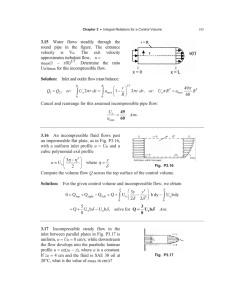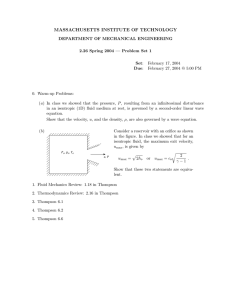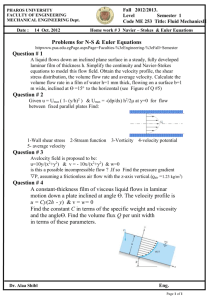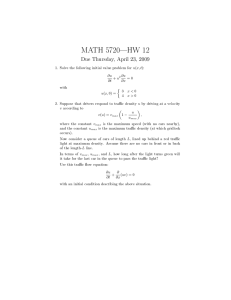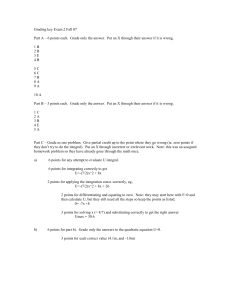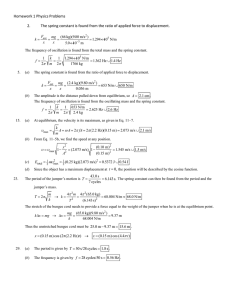Pipe Flow Analysis: Velocity, Flow Rate, Shear Stress
advertisement
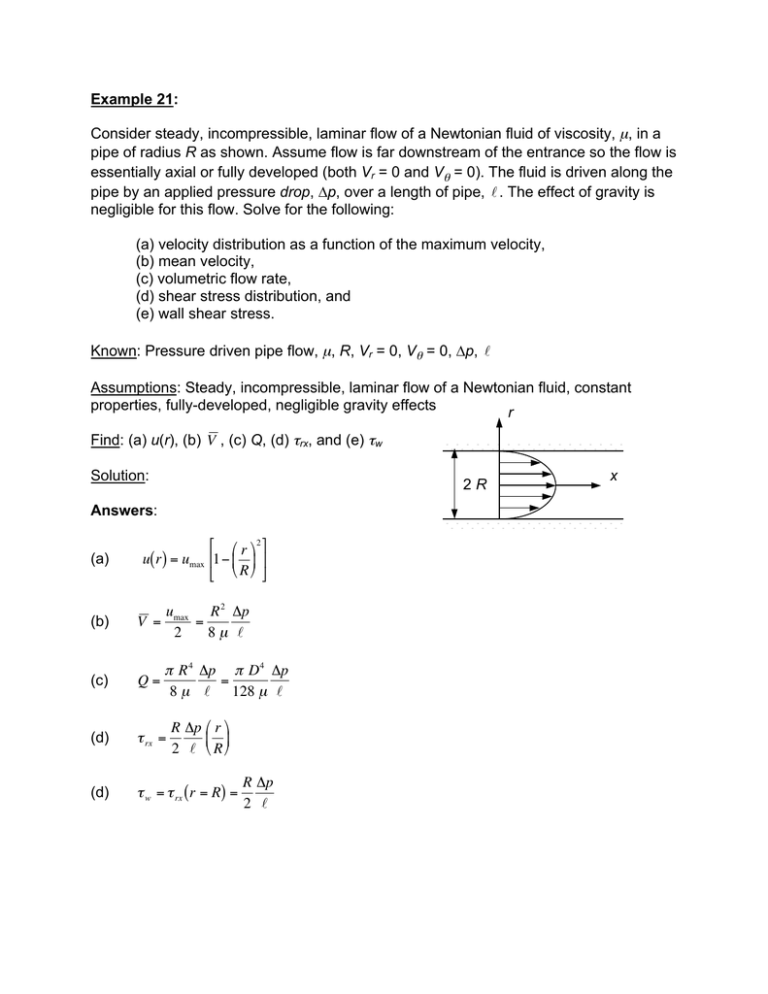
Example 21: Consider steady, incompressible, laminar flow of a Newtonian fluid of viscosity, µ, in a pipe of radius R as shown. Assume flow is far downstream of the entrance so the flow is essentially axial or fully developed (both Vr = 0 and Vθ = 0). The fluid is driven along the pipe by an applied pressure drop, ∆p, over a length of pipe, . The effect of gravity is negligible for this flow. Solve for the following: (a) velocity distribution as a function of the maximum velocity, € (b) mean velocity, (c) volumetric flow rate, (d) shear stress distribution, and (e) wall shear stress. Known: Pressure driven pipe flow, µ, R, Vr = 0, Vθ = 0, ∆p, Assumptions: Steady, incompressible, laminar flow of a Newtonian fluid, constant properties, fully-developed, negligible gravity effects r € Find: (a) u(r), (b) V , (c) Q, (d) τrx, and (e) τw Solution: 2R € Answers: (a) ⎡ ⎛ r ⎞ 2 ⎤ u( r) = umax ⎢1− ⎜ ⎟ ⎥ ⎣ ⎝ R ⎠ ⎦ (b) V = umax R 2 Δp = 2 8µ (c) Q= π R 4 Δp π D4 Δp = 8 µ 128 µ (d) τ rx = (d) τ w = τ rx ( r = R) = € € € € € R Δp ⎛ r ⎞ ⎜ ⎟ 2 ⎝ R ⎠ R Δp 2 x Analysis: (a) Calculate velocity profile, u(r) Conservation of mass for incompressible flow: 1 ∂ ( r Vr ) 1 ∂V ∂u θ ∇⋅V = + + =0 r ∂r r ∂θ ∂x For fully developed flow, Vr = Vθ = 0, thus € ∂u =0 ∂x (which satisfies the fully developed condition) Momentum equation for steady state, incompressible, constant property flow € DV ρ = ρ g − ∇p + µ∇ 2V Dt For fully-developed flow in a pipe there is NO fluid acceleration € DV ∂V ap = = + V ⋅∇ V =0 Dt ∂t ( ) and for negligible gravity effects ( ρ g ≈ 0 ) momentum equation reduces to € µ∇ 2V = ∇p (balance between forces due to viscosity and pressure). € r-component of momentum equation for cylindrical coordinates: € µ∇ 2Vr = ∂p ∂p ⇒ = 0 and ∂r ∂r p ≠ f ( r) θ-component of momentum equation for cylindrical coordinates: € € €1 ∂p ∂ p ⇒ µ∇ 2Vθ = = 0 and p ≠ f (θ ) r ∂θ ∂θ thus, p( x ) and can write € € € € ∂p dp Δp = = ∂x dx € x-component of momentum equation for cylindrical coordinates: ⎡1 ∂ ⎛ ∂u ⎞ 1 ∂ 2 u ∂ 2 u ⎤ ∂p µ ⎢ ⎜ r ⎟ + 2 2 + 2 ⎥ = ∂x ⎦ ∂x ⎣ r ∂r ⎝ ∂r ⎠ r ∂θ € µ d ⎛ du ⎞ Δp ⎜ r ⎟ = − r dr ⎝ dr ⎠ (where for u(r) we can use ordinary derivative) Integrate once to get: € ⎛ du ⎞ r € 1 Δp ∫ d⎜⎝ r dr ⎟⎠ = − µ ∫ r dr du 1 Δp r 2 =− + C1 dr µ 2 Integrate again to obtain: € 1 Δp ∫ du = − 2 µ u=− € ∫ r dr + ∫ r 2 Δp + C1 ln( r) + C2 4µ L Impose boundary conditions: € C1 dr r du = 0 by symmetry and u( r = R) = 0 (no-slip at wall): dr r= 0 du 1 Δp r C1 =− + dr µ 2 r € 1 Δp 0 C1 =− + =0 µ 2 0 € € du dr r =0 € R 2 Δp u( r = R) = − + C2 = 0 4 µ € ⇒ C1 = 0 R 2 Δp ⇒ C2 = 4µ Substituting back into our solution: € €2 R 2 Δp ⎡ ⎛ r ⎞ ⎤ u( r) = ⎢1 − ⎜ ⎟ ⎥ which is a parabolic velocity profile 4 µ ⎣ ⎝ R ⎠ ⎦ Write in terms of the maximum velocity umax at the center of the pipe at r = 0 € 2 R 2 Δp ⎡ ⎛ 0 ⎞ ⎤ u( r = 0) = ⎢1 − ⎜ ⎟ ⎥ = umax ⇒ 4 µ ⎣ ⎝ R ⎠ ⎦ € ⎡ ⎛ r ⎞ 2 ⎤ u( r) = umax ⎢1− ⎜ ⎟ ⎥ ⎣ ⎝ R ⎠ ⎦ umax = R 2 Δp 4µ € (b) Calculate the mean velocity, V € V = 1 ρA ∫ € 1 V = π R2 € 2 umax V = R2 V = € A ρ u dA € 2π R 0 0 ∫ ∫ ∫ R 0 2 u( r) r dr dθ = 2 R ⎛ r 3 ⎞ 2 umax ⎜ r − 2 ⎟ dr = R ⎠ R2 ⎝ ∫ R 0 umax ⎡ ⎛ r ⎞ 2 ⎤ ⎢1 − ⎜ ⎟ ⎥ r dr ⎣ ⎝ R ⎠ ⎦ R ⎛ r 2 ⎛ 1 1 ⎞ r 4 ⎞ − ⎟ ⎜ − 2 ⎟ = 2 umax ⎜ ⎝ 2 4 ⎠ ⎝ 2 4 R ⎠ 0 umax R 2 Δp D2 Δp = = 2 8µ 32 µ (c) Calculate volumetric flow rate, Q € ⎛ R 2 Δp ⎞ 2 Q = V A = ⎜ ⎟ (π R ) 8 µ ⎝ ⎠ Q= € π R 4 Δp π D4 Δp = 8 µ 128 µ (d) Calculate shear stress distribution, τrx € 2 ⎛ du ⎞ ⎛ −2 r ⎞ d ⎡ ⎛ r ⎞ ⎤ τ rx = µ ⎜ ⎟ = µ umax ⎢1 − ⎜ ⎟ ⎥ = µ umax ⎜ 2 ⎟ ⎝ dr ⎠ ⎝ R ⎠ dr ⎣ ⎝ R ⎠ ⎦ τ rx = € R Δp ⎛ r ⎞ ⎜ ⎟ 2 ⎝ R ⎠ (e) Calculate wall shear stress, τw = τrx(r = R) € τw = € R Δp D Δp = 2 4
